TABLE OF CONTENTS
- Four Directions
- The Law of 4
- Horned Beasts
- Bears
- Horses
- Eagles
- Birds
- Butterflies
- Dogs
- Rabbits
- Tigers
- Elephants
- Cats and Mice
- Fish
- Cattle
- Foxes
- Pigs
- Serpents
- Miscellaneous
- Uncertain
FOUR DIRECTIONS
There’s around 40 different animal types referenced in the film (overtly and subtextually), many of which have clear correlations to the different characters in the film. Jack is most often seen around large, aggressive horned and antlered beasts and dogs, Danny is closely connected to free-flying winged creatures, Wendy to the protective bear, and Hallorann to the wily rabbit and the slippery fish. But the hotel itself contains about 80-90% of these dozens of references, so it can be difficult finding clear consistencies, though I think as you go, you’ll get a sense for which bird reference speaks to Danny’s independence, and which speaks to his endangerment.
There’s also the issue of cultural motifs that go along with certain of these animals and not others. The butterflies in the film, for instance, speak to the notion of symmetry, resurrection, murder, and the foolish pursuit of dreams. The film’s story unites these notions well enough, but how do we know which is which and when? How do we know when our interpretation has reached the limits of intention?
Well, one thing I noticed in the film is that there are many instances of the following shape:

Ancient coin enthusiasts will recognize as the symbol of the four-spoke wheel that appeared on Athenian currency, known as didrachm…

…which Greek myth enthusiasts might know was an object that also bore the image of the minotaur and its labyrinth. So it’s possible that each of these symbols in the film, is simply a reminder of the end of the film, and Jack’s role as the minotaur to Danny’s Theseus.

But what I find even more interesting is how it resembles the indigenous concept of the Four Directions.

I didn’t realize this before, but the Four Directions actually have a host of attributes for each quadrant, and more than that, what goes into each quadrant depends on which community is showing you the Four Directions. The attributes are determined partly by the peoples who have determined what goes where, and partly by the individual themselves (although this might be a more recent development, or a sign of my own inexperience with the form). So your community can make its own, as many have, according to what makes the most sense to them, where they are in the world. This is a strikingly undogmatic way of approaching life (not with regard to specific, connected rituals, but with regard to the practice as a cultural idiom) flexible with its environs, as opposed to more dogmatic traditions, which try to impose the same logic to every environ.
The following rendition almost seems tailor-made for interpreting The Shining.
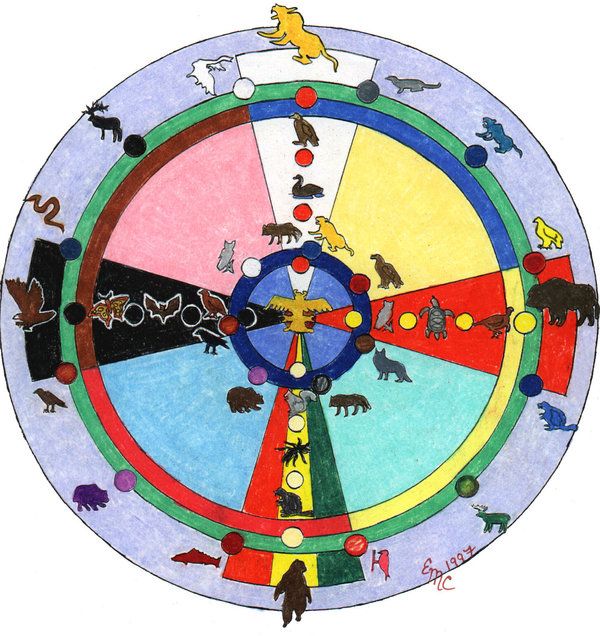
The one major consistency seems to be that most agree the main animals for these sections are the bear (Wendy), the wolf (the Overlook), the bird (Danny), and the buffalo (Jack). Though there are exceptions to that rule too.

So perhaps in the same spirit as he put the four seasons of the Overlook photos here in a wonky order, Kubrick was saying The Shining was his way of assigning the Four Directions.

RETURN TO:
THE LAW OF 4
I’ve written about this extensively elsewhere, but just in case this is your first stop on this site, the four directions isn’t the only thing in the film that seems to study things in sets of four. There also seems to be a vast concern for the four horsemen of the apocalypse, and an even vaster concern for the Fab Four themselves, the Beatles. There’s also a spatial rule of four going on with four of the main areas of the hotel, which I discovered doing this analysis of the photographs that appear in the lobby, the games room, the west lounge, and the east lounge. And if you hadn’t heard that The Shining bears more than a few stylistic similarities with Shutter Island, that film is all about the law of 4.
It’s possible there’s a heap of other law-of-4 moments in the film (like, I could see there being patterns among the paintings in the film that symbolically segment the four main figures in the film–and I’m just spit-balling here, but the Dorothy Oxborough paintings might be associated to Danny, the Colvilles to Wendy, the Vesuvius pieces to Jack, and the Grady twin/Cattermole pieces to the hotel), and if I think of any more I’ll try to let you know here.
Actually, while working on the next documentary series for YouTube, I realized while scrutinizing the nature of the mirrorform, that the first shot in the film is like a four directions wheel. The “Jack” mountain is Goat Mountain (horns), the Wendy mountain is Four Bears mountain (bear), the Overlook sky is what it is because there’s a mountain tucked back there called Almost-a-Dog mountain (wolf), and the Danny water/sky is what it is because the island in the middle is Wild Goose Island (bird) and it reflects in the water, and not the sky. As we saw a few images back, the circle in the centre can represent “the creator/the self”, and Danny would seem to be our most important perspective character, so having Wild Goose be there as well would make sense, I think.
The tantalizing insinuation here is that Wendy and Jack have dual selves (because their sections are made up entirely of mountains and their reflections), while Danny is something like a reflection of the Overlook, which, according to one of my analyses, is a metaphor for life itself. So Danny is like a reflection of life. What does that imply? I’m not entirely sure.

So anyway, the first shot is (among many other things) telling us that the way to really understand this film’s nature is through this ancient indigenous philosophy. What’s cool about that is that the last shot in the film is doing something very similar, giving us a second code sequence for decrypting the film’s layers of meaning (which I discovered long after noticing a law-of-4 buried in that larger pattern). And in the mirrorform, these two codes appear at the same time, right? So the first shot of the mirrorform is literally like the legend and map at the start of a maze.
RETURN TO:
HORNED BEASTS
The opening shot of the film features a helicopter shot racing up upon Wild Goose Island in the middle of St. Mary Lake, but the mountain to the right is called Goat Mountain, while the ones to the left are called Red Eagle Mountain, Four Bears Mountain and Little Chief Mountain. Since Wendy will be associated to Bears, Danny will be associated to birds, and Jack will be associated to horned creatures, this shot sets up the story in a heartbeat. The little goose is stuck between a goat and some bears.

A bull figurine sits above Wendy’s head on the bookshelf.

A woman walks into the Overlook, carrying luggage, and says goodbye to Ullman, and he reacts as if there’s nothing strange about this. But she’s (possibly) wearing a Toronto Toros jersey. Toro means “bull”. She’s also holding another jersey in her arm that strongly resembles the Dallas Stars. The minotaur’s name, Asterion, means “starry”, and he was sometimes depicted surrounded by balls, thought to be symbolic of stars.
My strongest alternate theory is that it’s a reference to Claude St. Louis of the Trois-Rivières Ducs, as seen below. Though this would seem to be not as thematically consistent. And the middle red stripe on the jersey looks wider than it did on the Ducs jerseys. All that said, it could be another fabrication, like the Stovington Eagles shirt Jack will be wearing later, in this case designed to resemble both teams. The Ducs were only around from ’69-’70, and St. Louis was far from their star player. Though that would speak to the Summer of ’69 theory.
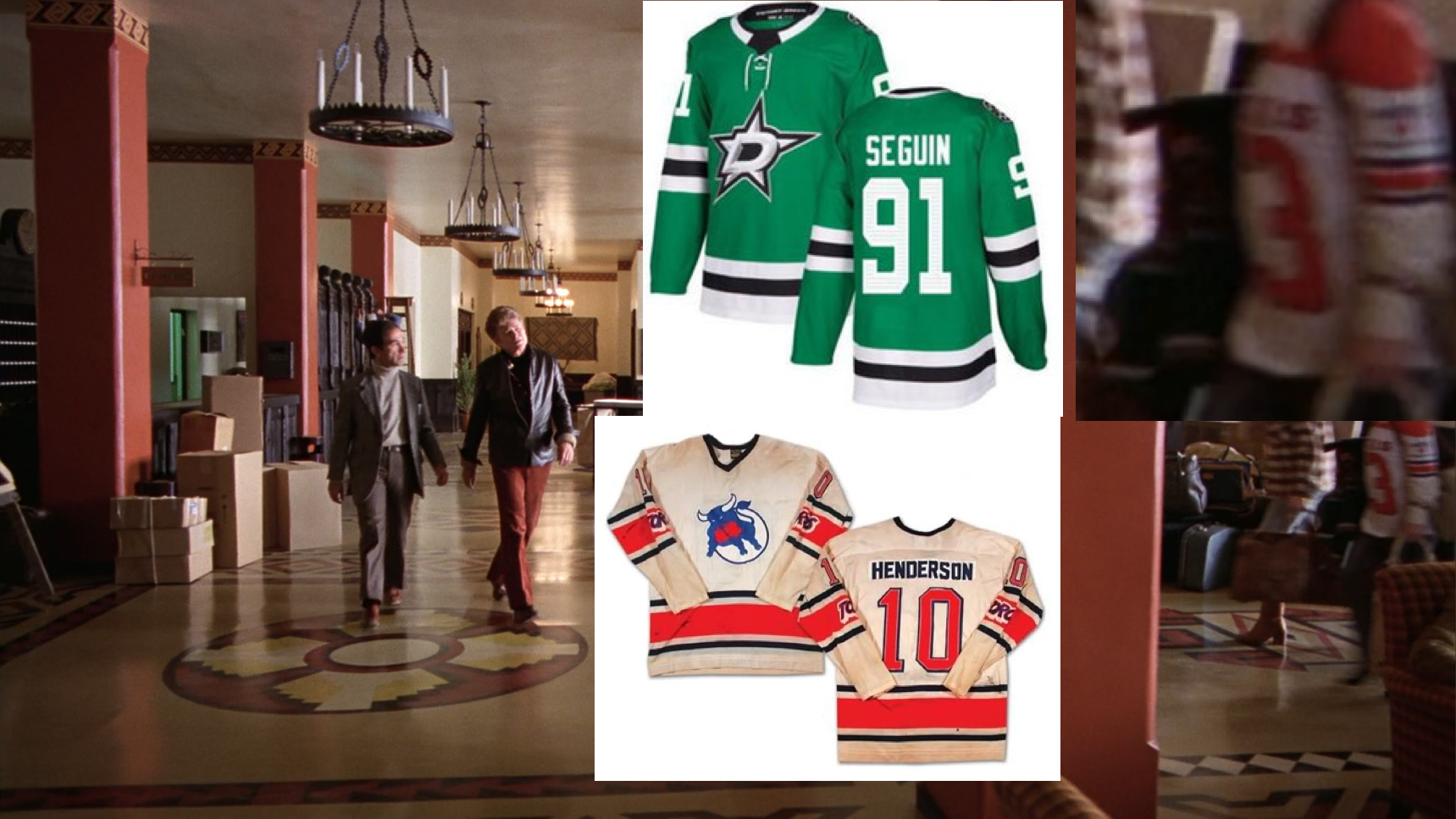

The gang passes a portrait of Tatânga Mânî (Walking Buffalo), AKA George McLean, a chief of the Bearspaw peoples of Alberta.

Ignore the Broadmoor poster, I was just pulling from my image directory.
Danny’s playing darts, which means he was aiming for a bull’s-eye, and, sadly, missing.
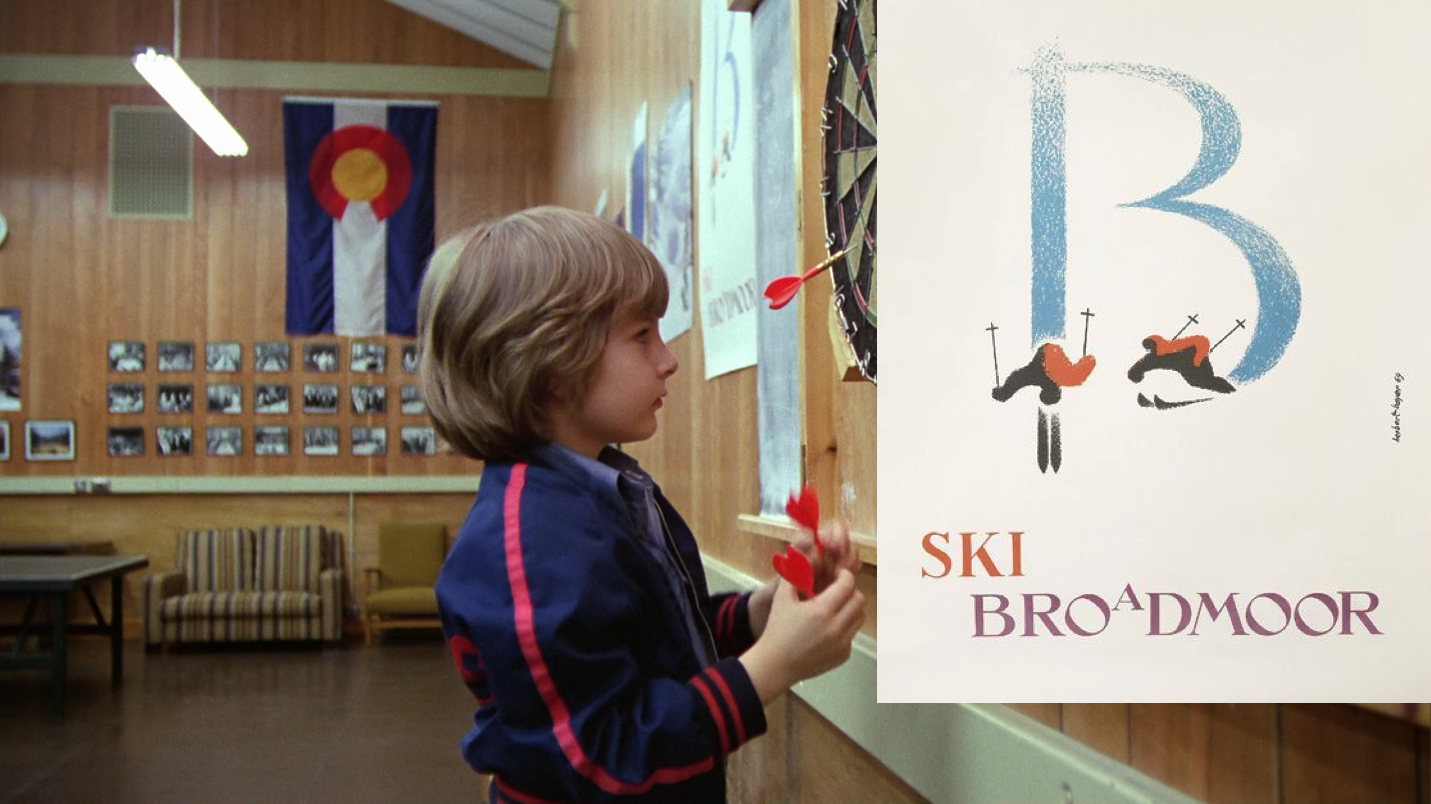
Three AMC Matadors appear in the film, and someone thinks one of Danny’s toys might be as well (someone else thinks it’s a Mercedes 350SL). I’m not a car guy. But that’s still a lot of confirmed bullfighters.

Jack whips a ball between a stuffed bison head and a stuffed moose head.

I realize antlers aren’t horns, but it’s more about the symmetry of the protrusions. The dog that sits between the buck and the hare in this part of the hotel probably has something to do with the idea of hunting, since spaniels are good hunting dogs.

Marlboro’s slogan was “Mild As May”. There’s a lot of invocations of the month of May (the astrological month of the Taurus) throughout the film, but I thought I would just point this one out, since the Marlboro mascot for many years was the Marlboro Man, a rustic cowboy figure, who no doubt drove his fair share of imaginary cattle over the years before imaginarily dying horrifically of stomach-churning lung cancer.

Hallorann appears to have a young gazelle head on his wall. Is it real? It’s hard to say. He has a tiger and a rabbit figurine that are definitely not real, so he might just be a fake animal enthusiast.

The cartoon behind Durkin, To Itch His Own, features a bulldog named Butcher.

“Are we feeding deer to death?” asks this issue of Outdoor Life.

The blood stain from Wendy slashing Jack’s hand takes on a kind of bullishness.

A painting of two muskox hangs outside the blowjob room. I still haven’t pinned down the exact artist behind the one in the film, though I believe it to be the work of Elizabeth McClellan.

BEARS
As noted, two of the peaks here are connected to Four Bears Mountain.

The mountain at the furthest left region in both images below is Curly Bear Mountain. So the third shot in the movie has gone from Four Bears to Four Bears and a Curly Bear. That’s five bears total.

This funny little black bear appears behind Wendy’s shoulder, hearing about the job, and before Jack in his last scene before going five alarm chili on his family. My complicated theory about this bear is that it represents the hotel’s ill will against Hallorann.

Danny sleeps on a bear.

As discussed, Tatânga Mânî was a chief of the Bearspaw people.
Danny has a bear drawing/painting over his bed of two bears, very similar to William Holbrook Beard’s Dancing Bear series.

Half-obscured on the notice board in the boiler room, down beneath the many nude photos/artworks, is this strange old bear art–if that’s what it is. I’ve long wondered if this isn’t some super obscure Teddy bear’s picnic kind of thing, that was never meant to be properly identified. If it is a Teddy bear’s picnic reference, Jack will later hear a song (while listening to Grady rant about his family’s lack of love for the Overlook) by Henry Hall and the Gleneagles, whose other big hit was Teddy Bear’s Picnic. Here, Wendy is trying to keep the Overlook from exploding, while Jack is having a nightmare about murdering her and Danny.

The bear rug, from every other lounge scene, disappears when Wendy goes to fight Jack. I just thought I’d point that out, in case you don’t read the section on disappearances.

Here’s the scene with the Gleneagles song, Home.

Winnie-the-Pooh in the distance there, but Danny’s robe gives him a fairly similar colour vibe.

Outdoor Life‘s cover story reads “So near to the Grizzly ‘I had to pay for it'”. And in just a few short minutes Jack will be getting a slash to the hand from Wendy’s blade, standing right beside this magazine.

What is that Winnie-the-Pooh-coloured Predator-mouthed bear mask with Wendy Torrance’s eyelids doing in that room? Surely only good things.

HORSES
Horse rides are offered twice a day at the merry old Overlook.

Cornelius Krieghoff’s Log Hut on the St. Maurice contains a horse-drawn sleigh.

The weird little art piece next to Ullman’s briefcase could be almost anything, but it’s always struck me as being something like a mule or dog or llama or something. For the sake of not repeating the unclear, I’ll just make a note of it here.

Alex Colville’s Horse and Train is possibly his most famous work. In this room it hangs across from his other piece, Woman and Terrier.

Cut out from view in the first breakfast scene, this wider shot of the Torrance apartment lets us see that the upper two levels of the bookcase have what may be two horse heads acting as bookends. They look like chess knights from an impossibly large set. Are Wendy and Danny the “knights” above Jack’s bull figurine?

Some kind of show pony photograph hangs below the bison head.

Both Krieghoff paintings feature a horse-drawn sleigh, although only the one, Winter Landscape, seems to be carrying people.
Jerry Brimacomb’s famous Steamboat ski poster features a couple horses riding skiers with their equipment, and Frederic Remington’s The Cowboy is one of the most iconic, Romantic paintings of the noble wild west cowboy. It’s also possible that the poster in the middle, of the Denver 1912 flood, contains animal imagery that is otherwise impossible to make out. I’ve wondered a few times if the orange figure at the bottom centre isn’t a lion. Also, Steamboat seems to be a reference to Steamboat Willie (Mickey Mouse) who shows up on Danny’s door in Boulder, and later on his sweater.

There seems to be a donkey on the Nugget brand whatever to the left of Danny’s head here.

There’s a horseshoe in the radio room, at the one-third mark of the film. Which means that all the horse references happen in the first third of the film. I’m not sure what that means, if anything, but it is notable.

EAGLES
The mountain on the far left is Red Eagle Mountain…

…which in this image (the third shot of the film) is dead ahead.

Ullman and Watson have eagle statues by their heads, and as elsewhere discussed, the one behind Ullman’s shifts throughout the film, notably moving to hide behind his head in the close ups of this scene, which occasionally makes it look like he has little dark red horns (see below). Jack doesn’t have an eagle statue by his head, but I read in one of the books on the career of Kubrick that Ullman has something in this room indicating he was a boy scout. So perhaps one of the plaques near Jack’s head is an eagle scout award. If anyone can confirm that, I would appreciate it, but my research has been inconclusive.


Stovington is the fictional school where Jack was ousted for abusing a student. So anyone who’s ever claimed that the clothes in the film were probably just whatever the costumer picked up at the thrift store that day is overlooking the fact, at the very least, that this outfit was fabricated.

The Adler typewriter icon is an eagle.

The US Forest service has one atop their flag.

The new dark grey Adler typewriter also has an eagle decal.

The Gleneagles were called the Gleneagles because they played in the ballroom at the Gleneagle hotel. And their performances would be broadcast live over the radio circa 1924-1932, when Henry Hall played there. Their other hits were Teddy Bear’s Picnic, and also Here Comes the Bogeyman. Napoleon (the man who gave birth to the bogeyman legend) was a personal obsession of Kubrick’s, and he had plans to make a Napoleon film throughout parts of his life. In fact, his abandoned Napoleon project is still considered one of the greatest movies never made.

BIRDS
Flock of Loons by Copper Thunderbird (AKA Norval Morrisseau). Seen once in Susie’s office, and twice as Jack and Wendy pass the 2nd entrance. Notice how it contains 11 loons.

Susie’s office also contains the painting of two mallards of some kind, mirrored on the water, possibly by someone like JF Lansdowne, or Charles Tunnicliffe.

Beneath the last one (seen by Watson’s breast here) is one that is also seen near room 237 (not far from Jack’s writing table, as it happens), which is almost certainly painted by Charles Tunnicliffe. He’s the only artist of the era that I’ve yet discovered who painted mallards surrounded by liney, frosty reeds, and who painted the birds’ shadows on the ice. However, Tunnicliffe released a couple dozen collections, so tracking down the piece has been most difficult.

Toucan Sam makes a cameo appearance. Perhaps his slogan “Just follow your nose” has something to do with the blue-silver ball of thread drifting off to the side of the yellow pitcher above.
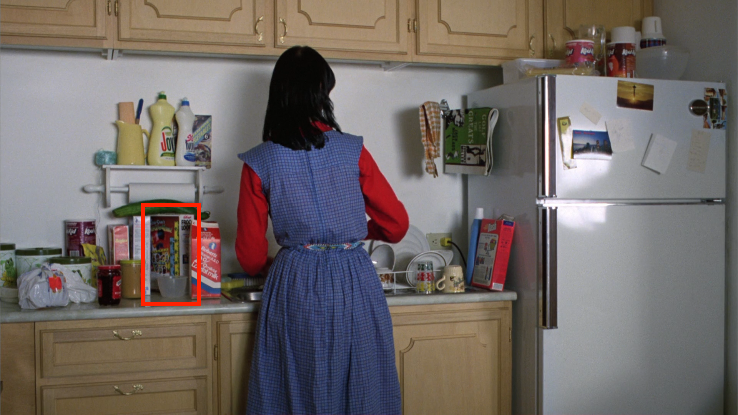
The Torrance food chart seems loathe to suggest the more common meats of the modern 1st world, in favour of game birds, hares, and fish. A broom handle seems inclined to point out some twin snails.

A little blue bird perches on a cherry blossom branch in the banner behind Wendy. This might be the work of Italian missionary turned Chinese court artist Lang Shining (AKA Guiseppe Castiglione, but that’s just a guess. It could just be an Asian banner not by someone who named himself Shining.

The brochures which overlaps the same spot as where Hallorann will later be axed are for Avis, which is the Latin word for “bird”.

Danny’s door is littered with birds, including a type of bird that is never seen anywhere else that I know of: an owl. That said, I might’ve read somewhere that the stain glass designs in the lounge are based on the form of owls, but I didn’t see that confirmed by my (admittedly very brief) research into the original designer of those designs. Note the rubber ducky behind the shower curtain, which will be in Danny’s room atop the window shelf during the doctor’s visit in a moment.

Hugh Monahan’s December Afternoon, and a similar painting likely by the same artist, hang in the lobby access hall, and the 2nd entrance hall. Then December Afternoon hangs alone to the left of the bloodfall in every vision. This piece seems to preempt Danny’s alarm in every instance (except when Wendy’s going to check out the dead snowcat or when she’s seeing the bloodfall herself, in which case it’s her alarm). As you can see here, it contains 24 geese. The other piece seems to contain only 5 or 6.

The fuzzy-felt FARM has two birds and a rooster. Also, I blocked the duck in this image, and I’m too lazy to get another one. So, use your imagination, I guess.

There’s a weird little eggman hiding in this shot. Goo goo g’choo.

Hallorann mentions the fowl in the same breath: “…12 turkeys, about 40 chickens…”

Note the CHICKEN MEAT in the foreground there. Looks quality.

I can’t make a positive ID on which FLYERS this is a jersey for. It looks a lot like some of the Dayton Flyers’ jerseys I’ve seen, but there are also the Waynflete Flyers from Portland, Maine, which would make the most sense, thematically.

The only evidence of actual animals in the entire film comes from three loon calls heard during the following three shots. Interesting that they would pair with the two instances of the family Beetle being visible outside the exterior.

Jack has three eggs for breakfast, just the way he likes em, sunny side up.

JF Lansdowne paintings of a glaucous-winged gull and a Cooper’s hawk, AKA a chickenhawk. Given all the underlying military/war themes, it’s interesting that Kubrick would pick a bird synonymous with someone who espouses a strong favour of war, but avoids military service, and that he would hang it to the right of possibly the most common gull in the world, while Danny is making his four left turns journey, here.

Louise-Amélie Panet-Berczy’s Sisters Creek AKA The Battle of Longue-Pointe AKA The Battle of the Barn. This one contains a flock of loons in the lower left of the image, and the painting hangs near room 237. Actually, right around the corner is that Tunnicliffe-style painting which also hangs in Susie’s office, which means it also hangs next to Flock of Loons. So perhaps this is Danny’s version of that piece, for some reason.

Not sure about this one. Looks like a bird in a nest, but I’ve been mistaken before. Reminded me of Robert Bateman’s work for a while, but I’m much less certain now.

Four paintings of birds that are the exact same as the stickers on Danny’s bedroom door, albeit in a slightly different configuration.

A super blurry painting of something like a quail or hummingbirds hangs behind retreating Jack’s head in 237.

Hallorann has a rooster atop his china hutch.
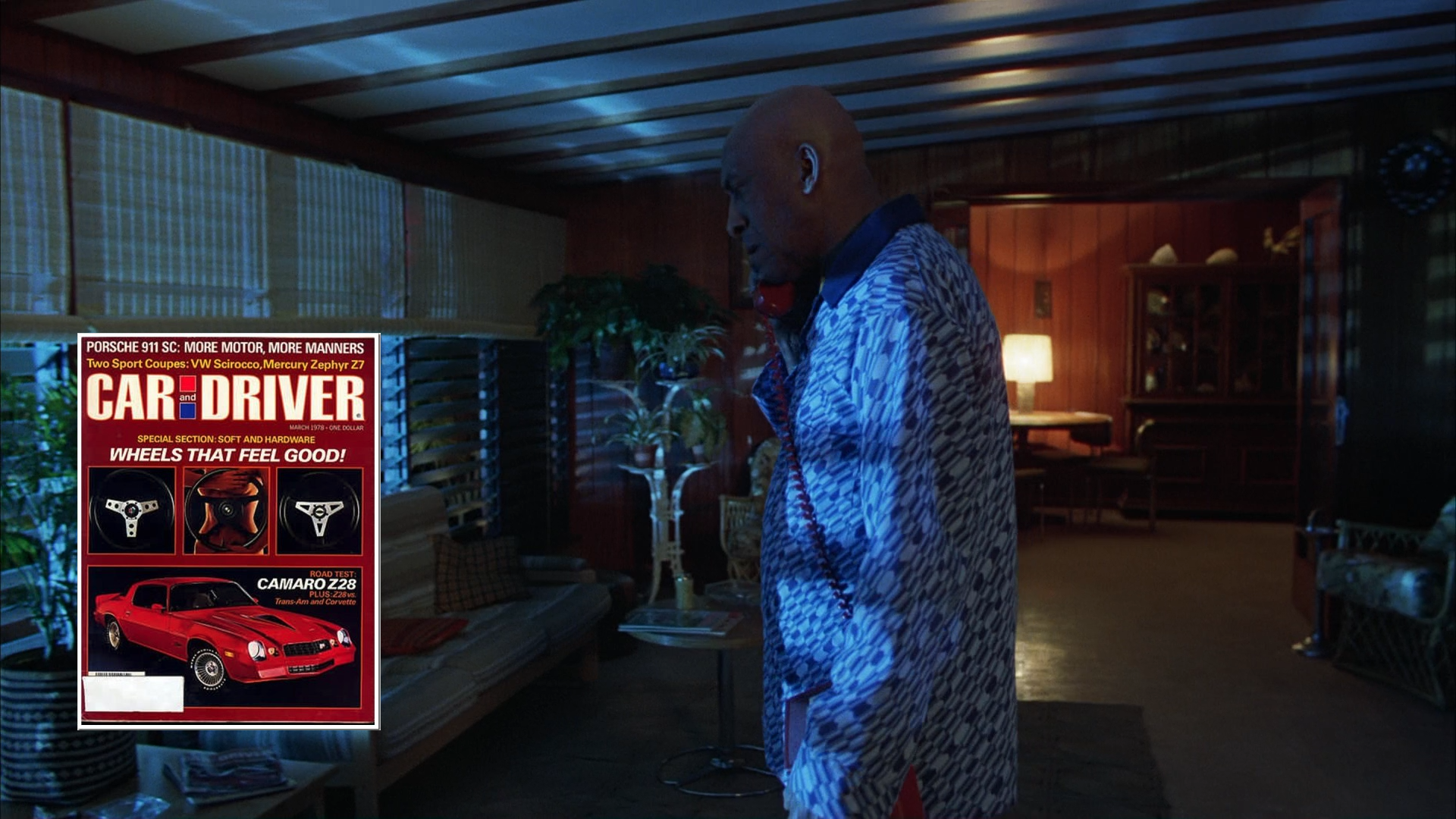
Many of the ghost ball ladies have feathered headdresses, but especially the one that tips Grady into Jack. Also the drink Grady spills into Jack is the egg-based advocaat.

The book second from the left on the second shelf features a bird perching on a branch along its spine. I’ve wondered if this might be To Kill a Mockingbird, but I haven’t been able to positively ID it.

The car that passes the parked car in this scene is a ’77 Pontiac Firebird.

This copy of Field and Stream features bird hunting tips.

Danny and Wendy watch The Roadrunner Show twice in the film, and actually watch the same episode in both instances.

When Jack’s locked away, the CHICKEN MEAT has moved over to this side.

Outdoor Life has a report from someone named Rald on “Duck hunting’s ‘Isle of Shame'”. The story on this is somewhat interesting. A woman named Mary Monaghan went undercover to bust a duck smuggling ring, and became the first female agent of the US Fish and Wildlife Service killed in the line of duty (9 years after this film came out). And the so-called ‘isle of shame’ is an interesting place, it turns out. While that nickname referred to its illegal hunting practices, today it might turn out to be the first island in continental America to be rendered unliveable by climate change. Fun question: who do you suppose 87% of its population voted for?

I’ve narrowed the two birds in the accountant’s office down to either plovers or sandpipers. Either way I can’t find the exact painting, though this Lansdowne comes awful close. Also, the name of the door here is seen multiple times throughout the film, and it’s HENRY CALLAHAN, which happens to be the name of one of the progenitors of Ultimate, the sport of playing frisbee. Callahan had been a student at the university of Oregon when this was being made, and had started a team called The Low-Flying Ducks. So I wonder if the Hugh Monahan paintings of low-flying geese that Jack just passed in this scene were a reference to that.

I couldn’t help but notice how the snow dust on Danny’s sweater, only after escaping the middle of the labyrinth, takes on a kind of bird shape. This would be an apt symbol, given how Jack, upon reaching the end of Danny’s steps, looks into the sky as he screams out Danny’s name, as if the boy had literally ascended.

The squinty woman next to photo Jack has, like many of the women in the crowd, a little heart-shape on her dress, but she seems to have taken extra care to make hers look like a bird, and stuck a feather in it.

BUTTERFLIES
There is no Ski Monarch poster that looks anything like the one in the film. But a monarch is a butterfly that “overwinters”, meaning that it travels to warmer climes during the cold winter months. The film is, of course, all about overwintering, and what happens when the wrong person performs the worst opposite of overwintering. Also, the twins have a certain butterfly quality, don’t they?

A little display of butterflies sits by the Suite 3 mirror, but it wasn’t there during the tour, and for one shot later in the film, when Danny is seeing zombie Jack on MONDAY, the display vanishes again, only to reappear when we cut to Jack seeing Danny. There seem to be about 7-8 bugs on the model, but it’s never perfectly clear.

The Gold Room bathroom tissue box features a butterfly. Apparently in Christian mythology a butterfly symbolizes resurrection, so the fact that Grady cleans Jack off in Christ pose could be saying that Jack is being reborn here into his antichrist self. Or it could simply be a callback to the Grady twins with their monarch poster. Or both!

These butterfly paintings appear later in the film, during the zombie Jack vs. Danny section. But we don’t get both until the Wendy plotting escape moment, here. In fact, this is the only shot of both. It’s unclear, but both seem to have 4-5 butterflies apiece.

There’s also something like a tweezer kit (lower left, the red/white/black thing) on the makeup table that looks a bit like a butterfly, the way it’s splayed open.

DOGS
A Greyhound goes to the Overlook. That’ll be more significant later.

Krieghoff’s Log Hut on the St. Maurice features a tiny dog by the child standing near the door to the cabin.

Clarence Gagnon’s Trapper’s Camp features a dogsled, with three huskies by the look of it.

Roadrunner’s arch nemesis is the coyote, a kind of dog.

Alex Colville’s Woman and Terrier, which he called his Madonna and Child, for the way the dog seems to take precedence over the central woman figure.

There’s the blue-red dog on the art piece beside Wendy’s leg, and the blue-red Goofy figurine on Danny’s shelf.

There’s the huge rollerskating rainbow Snoopy sticker on the door (along with five tinier ones), but also the one in the hot air balloon in the top right corner of the room.

Krieghoff’s Winter Landscape has a tiny dog squaring off with the family horse.
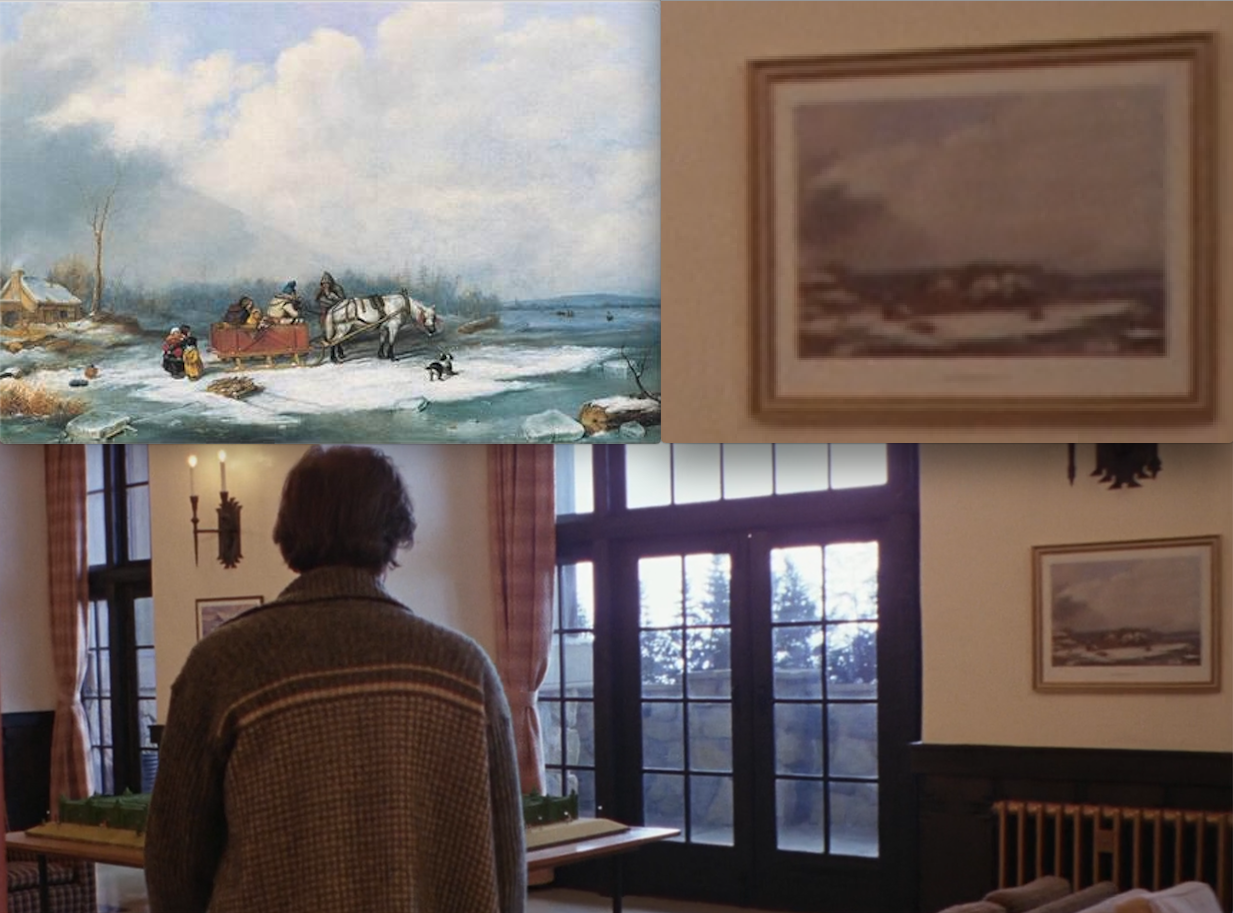
Alex Colville’s Hound in Field, featuring a beagle, alongside possibly a piece by Colville’s good friend Avery Vaughan, featuring an Irish setter with her pups.

I haven’t confirmed this, but the closest thing I’ve yet found to the dog painting here is Edwin Megargee’s English Springer Spaniel, which this dog most certainly seems to be. Megargee was the artist responsible for designing the Greyhound logo, so that makes for a neat little connection to Jack’s intro, if at all intentional.

Alex Colville’s Dog, Boy, and the St. John River. Seen only in a mirror inside room 237, with the dog blotted out by a lampshade.

Some kind of bulldog hangs inside 237. Another Megargee, perhaps?

A Brittany Spaniel and a German Shepherd. The Shepherd appears on the way to the ghost ball and also on the way out the 2nd entrance.

Lloyd asks Jack what he can get, and Jack replies “Hair a the dog that bit me!” This seems apt given that dogs were all over the inside, the foyer, and the outside of 237, and in the lobby on his way here. 237 is the reason he’s here.

The cartoon behind Durkin features two dogs, as does the Perky Pooch air fresheners on the wall.


The radio host Charlie warns that Wolf Creek and Red Mountain passes are closed.

Another Wile E. Coyote.

Jack pretends to be the big bad wolf before slamming the axe home. And when he’s defeated at the end, hearing the snowcat revving up for the final time, he seems to howl out like a wolf.

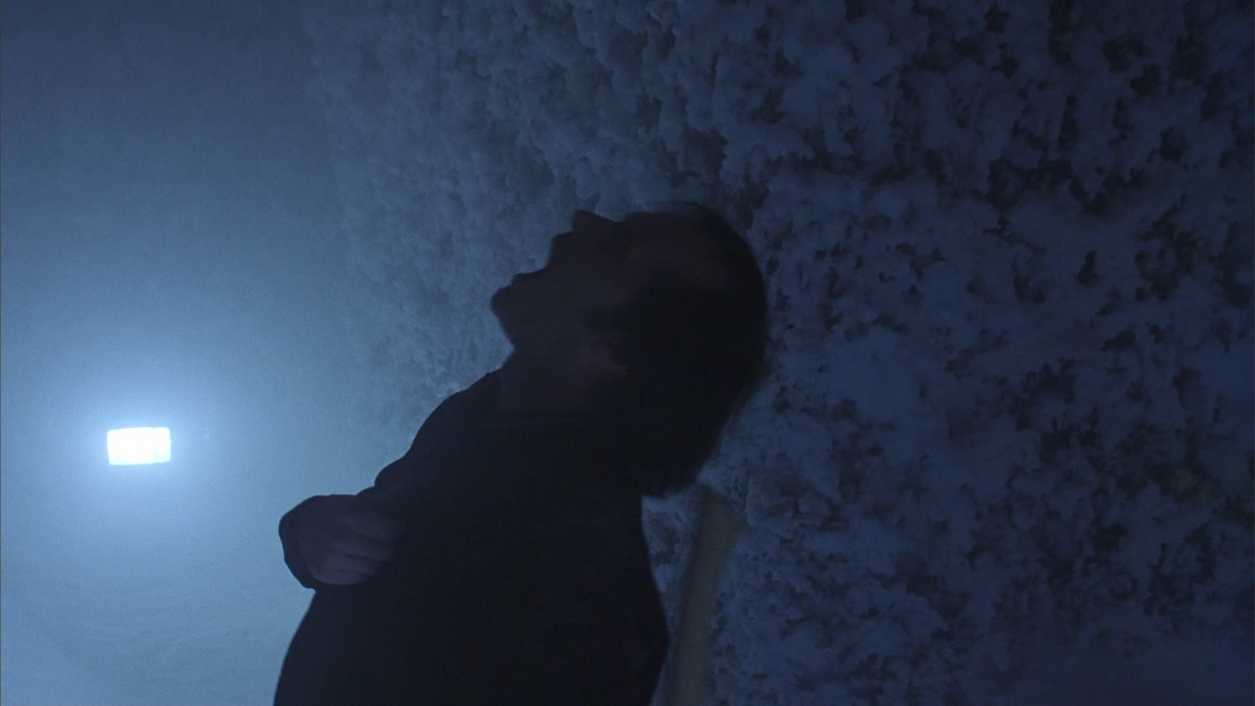
RABBITS
Danny wears a shirt with Bugs Bunny on it.

The food chart has a hare.

Hallorann imitates Bugs.

Bugs appears in the spot where Hallorann gets axed.

A hare, and possibly its child(?), appear around the corner from 237, where Danny receives two shines of a sort, the Grady twin flash and the rolling ball.

Dick has a little rabbit figurine above his radio.
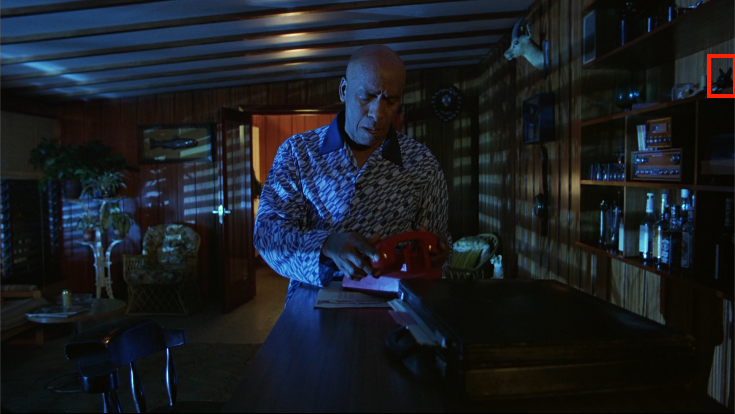
TIGERS
The cartoon Danny watches twice during the film, Stop! Look! and Hasten!, features Wile E. Coyote leaping into a deadfall with a Burmese tiger (or, in the twinnified Latin, surprisibus surprisibus–reminds of the latin inscriptions under the John Gould paintings…).

There’s the tiger mask atop Danny’s shelving, but there’s also the large cat art on the black board by his door. Probably a lion, but it is quite orange.

Two books in the living room have Tiger in or near the title, referring to the main character. Also, Anne Jackson, who plays the doctor, starred in a film called The Tiger Makes Out, which featured her costar and real-life husband, Eli Wallach, on the poster with a large tiger tail.

Tony the Tiger shows up three times in the film. Once in bulk, with three visible forms across seven boxes.
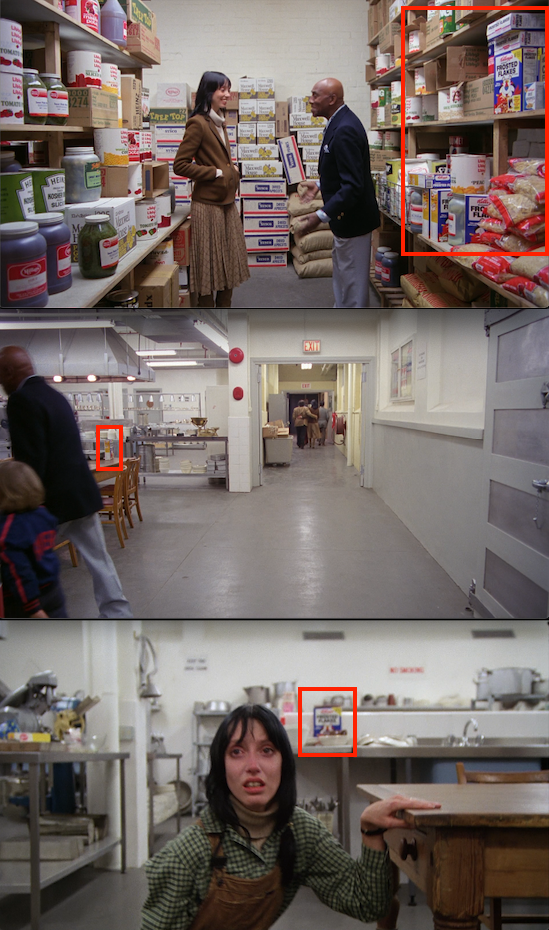
Hallorann has a little tiger statue.

ELEPHANTS
Susie has a tiny elephant figurine.

There’s also a purple elephant in the room during the post-shine inquisition.

CATS AND MICE
During breakfast, Wendy sips from a mug that at first seems to only show Tom, but when she sets it down, flipping it around, we see Jerry features as well.

The first map of the Americas features a couple winged lions on the name plate. This is probably a reference to St. Mark or the prophet Daniel.

There seems to be a cat felt thing on the fuzzy-felt box. Also, there’s a little white cat squeeze toy in a fish bowl atop Danny’s shelf that disappears in the close-up on the doctor. And the yellow-orange animal on the black art piece might simply be a cat and not a lion or a tiger.

Mickey and Minnie mouse feature across the room on Danny’s door.

Ullman calls the Aktiv Snow-Trac a “snowcat”. Jack, Hallorann and Wendy both use this term in later conversations. “Go check out the snowcat and the radio, and you’ll see what I mean.” “That means I’m gonna need a snowcat to get up there, Larry. Can you fix me up with one?” “We have the snowcat. If the weather breaks, we might just be able to get down the mountain in that.” “I’m gonna try to get Danny down to Sidewinder in the snowcat today.”

Mickey Mouse is caught by a Jack attack.

Two bottles of Booth’s gin, featuring their red lion logo.

FISH
While I don’t think it ever shows onscreen (red box below), Jack passes Otokomi Mountain on his way up Going-to-the-Sun Road. Otokomi was the name of George Bird Grinnell’s part-Blackfoot hunting partner, and means “yellowfish”.

Ullman’s office features numerous photos of people fishing, and people stringing up their impressive catch.

Wendy’s food chart features three fish and a lobster.

Hallorann says, “Canned fish and meat”

Hallorann’s lamps all have sideways fish designs on them.

Jack says “Of course I intend to change my jacket this evening before the fish and goose soirée.”

Hallorann has at least one fish in a box on his wall. I’m wondering if the one beneath the gazelle head could be the same thing. It’s never perfectly clear.

Yes, pike *are* gamefish.

Outdoor Life is promising pages of news on bass and trout.

CATTLE
The only thing we see Danny drink is milk. Jack and Wendy are mainly seen drinking water and caffeinated beverages like Coke and coffee. Jack takes OJ with his bacon and egg breakfast, and of course drinks his ghost bourbon.

Ullman seems to have a portrait of some massive cow mixed in with all the fishing pics.

“…15 rib roasts, 30 10lb. bags of hamburger…50 sirloin steaks…”

The young woman in Sisters Creek is tending her red cow and foals.

Radio Charlie is saying “Get the cows in the barn.”

The pantry has oodles of stewed steak. And when Jack awoke by Grady, he’d cleaned out one of the corned beef tins.

And finally, Wendy passes Alex Colville’s Moon and Cow.

FOXES
The woman in this 18th-century art (hanging right outside 237) lived on an island which came to be known as part of the Fox Islands, so named by Russian fur traders.

The gingerbread man of fairy tale fame gets gobbled by a fox at the end of his story. The gingerbread man of Candy Land fame might have a different fate, but both Danny and Jack go into 237, which features two fox paintings.


PIGS
“2 dozen of pork roast”

Log Hut on the St. Maurice features a pig by a tipped over sleigh.

Fuzzy-felt Farm features a couple pigs.

The HiTails ad behind Durkin seems to have a little pig character.

“Little pigs…little pigs…let me come in!”

SERPENTS
The first map of the Americas features a mythical serpent beast swimming the waters west of the southern tip of South America. Damn leviathans! Always stymieing conquest.

Ullman references the town of Sidewinder, saying it would cost too much to keep the road there open in the winters.

Jack sticks his tongue out, or pushes it to the edge of his mouth, a lot. For a while I was thinking that the tongue thing was just an affectation of Nicholson’s for the character, but as you can see, every moment of Jack’s Tongue Acting but one comes after the murder dream, and all but two come after the “sell my goddamn soul” line.


Wendy references getting Danny to Sidewinder.

In the deleted scene at the end of the original cut of the film, Danny plays Snakes and Ladders at the hospital where Wendy is recuperating.

MISCELLANEOUS
The VW Bug/Beetle is the first easily recognizable animal reference in the film.

Wendy has a set of storage tins with little cartoon frogs on them. Danny has one in his bedroom, too.


The broom handle points out the twin snails on the food chart.

“…and 20 legs of lamb!”

Minced clams behind Danny.

The missing woman from the news disappeared while on a hunting trip.

The HiTails ad seems to include a raccoon and a squirrel?

The game of Tiddley Winks is derived from a French game called jeu de puces, which means “game of fleas”.
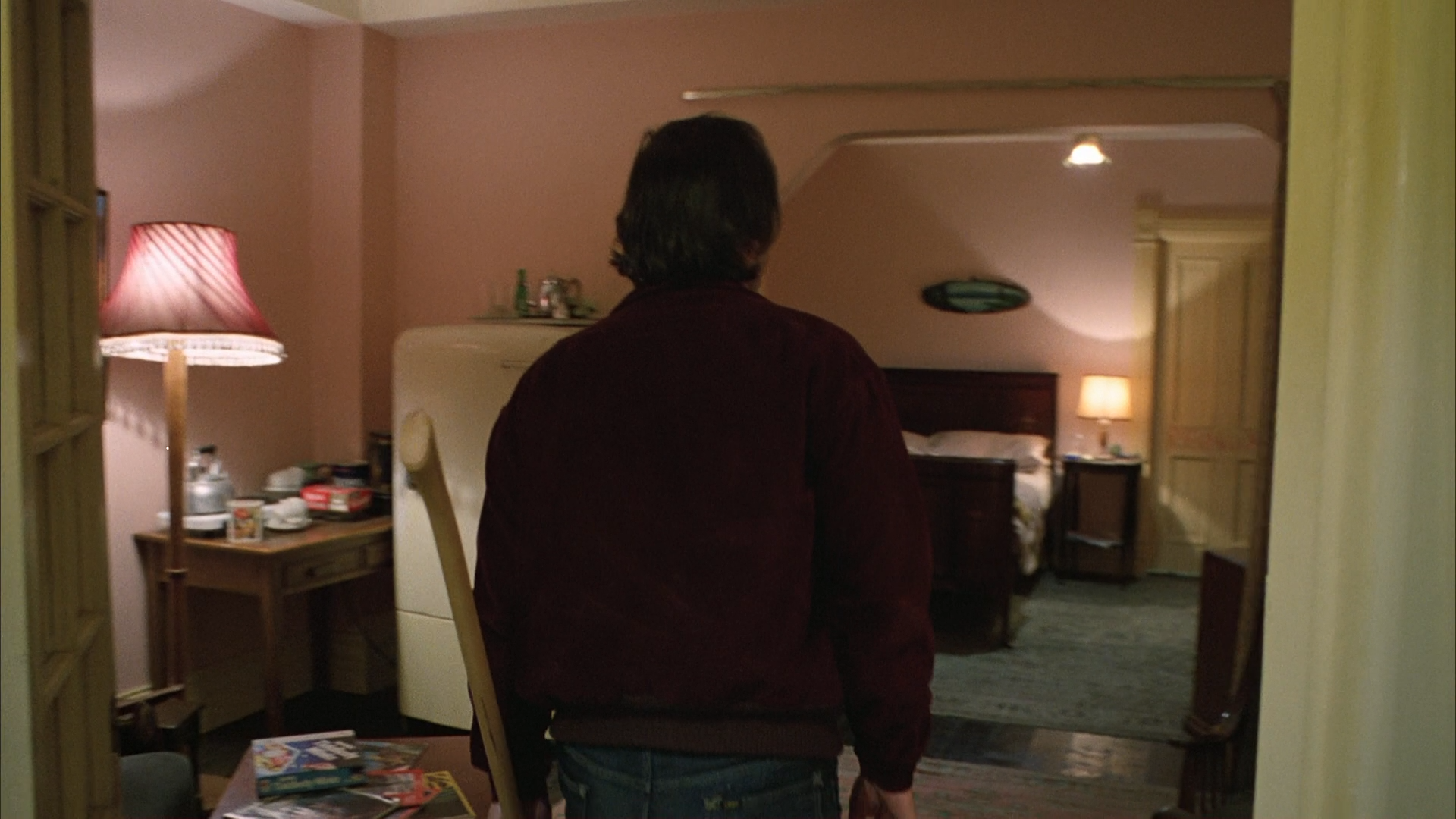
Lawren Harris’ Beaver Swamp.

UNCERTAIN
The weird shadow monster art in the hotel foyer has a hominid form, but also a large trunk. Is this an elephant man? A Cthulhu reference?

The poster behind the twins in the games room, memorializing the 1912 Denver flood might have some animals in the art. I’m less certain of this now than ever, but for a long time I thought I saw certain animal figures, so I’ll keep it here for now.

The art to the right here has at times resembled Tunnicliffe’s sketch of a dachshund being attacked by a badger, and at times resembled an ancient drawing of famine riding a lion. Either way, it’s inconclusive.
Actually, the war canoes in the opposing painting have animal designs on them of some kind.

The second last piece of art to appear for the first time in the forward-moving story (as opposed to the mirrorform), seems to be a sketch of three beasts staring out at the viewer, but it could be many things.

MAIN PAGE ⎔ SITE MAP ⎔ GLOSSARY
OTHER MAIN PAGES FOR SHINING ANALYSIS
THE MIRRORFORM ⎔ THE BEATLES ⎔ THE RUM AND THE RED
BACKGROUND ART ⎔ OVERLOOK PHOTOGRAPHS ⎔ GOLDEN SPIRALS
PHI GRIDS ⎔ PATTERNS ⎔ VIOLENCE AND INDIGENA ⎔ ABSURDITIES
THE STORY ROOM ⎔ ANIMAL SYMBOLS ⎔ THE ANNOTATED SHINING
